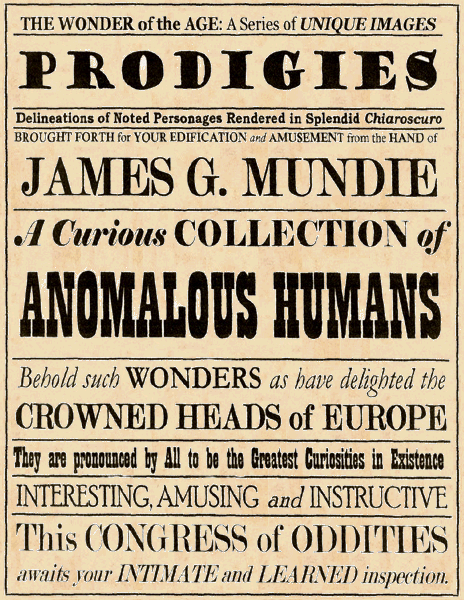Introduction to Prodigies, James G. Mundie's Congress of Oddities
This series features portraits of ‘anomalous humans’ — sometimes called “monstrosities” or
“freaks” — placed in contexts borrowed from famous artworks of the past.
In the spirit of the circus sideshow, where even a three-legged man would be re-invented to appear more interesting,
I have created new biographies for my subjects in which fact and fancy are liberally mingled. The resulting images confront the viewer with something that
may at once appear familiar, humorous, and startling.
The freakshow has a theatrical heritage of stylized presentation dating back many centuries in which the people on stage might appear as characters from myth or fable.
Very often, a great deal of fraud was involved, but this seemed only to delight patrons all the more. The performers themselves, though sometimes objects of ridicule,
participated in and helped shape this ritual of otherness, often to their own great financial benefit. This was, after all, a business tranasaction in which the talent
capitalized upon and fed the audience's curiosity.
Art history, like sideshow, has its own formal conventions and traditions; so it seems to me that blending the two is a natural pairing of ‘high’ and ‘low’ culture — especially since both appeal to one's voyeuristic inclinations. It is my hope that
these images compel the viewer to linger and consider their own inhibitions and conceptions in relation to a subject which many consider taboo.
These images grew out of several interests: an affinity for portraiture, a passion for art history, and a natural curiosity for pathology. In studying my subjects, I have
found an admiration for those dealt a cruel hand in life who managed to turn personal misfortune and adverse societal circumstances into opportunity. The first pieces in the
series came about through playing with some obscure Renaissance compositions that seemed ripe for revision. Soon I found that favorite paintings — whether through
narrative motif, setting, or gesture — suggested parallels to certain sideshow performers’ stage identities or physical conditions. One drawing led to another, and
the series has continued to evolve.
When deciding on a title for this series, I chose to avoid using the term “freak” outright because its modern usage has many negative
connotations; however, among performers the term was considered an honorific. The freak was an exalted individual in the sideshow business because as talented or flamboyant
a sword swallower, snake charmer, fire-eater, contortionist, or human ostrich might be (known in the trade as a ‘working act’),
they would never equal the draw of a genuine ‘living curiosity.’ The term freak itself is merely a shortened form of “freak of nature,” meaning
simply that which deviates from the expected — the exception that proves the rule. I chose the word “prodigy” to describe these people because the term in
its original meaning points to the larger historical view of these ‘strange people’: as portent, the exceptional or marvelous thing that inspires fear and wonder.
I invite those that may object to my choice of subject, or who fear the exploitation of a disabled minority, to consider the words of author Robert Bogdan who said:
‘Freak’ is a frame of mind, a set of practices, a way of thinking about and presenting people. It is not a person but the enactment
of a tradition, the performance of a stylized presentation.†
As a Victorian sideshow talker on the bally stage might say to draw a crowd to his ten-in-one and ‘turn the tip,’ “Here they are, splendidly fraudulent yet marvelous, brought forth for your
edification and amusement. This Congress of Oddities awaits your intimate and learned inspection.”
James G. Mundie
†Bogdan, Robert. Freak Show: Presenting Human Oddities for Amusement and Profit. Chicago: The University of Chicago Press. 1988
Brief biography of James G. Mundie
James G. Mundie is a graduate of the Pennsylvania Academy of the Fine Arts and the University of Pennsylvania.
Mundie's drawings, paintings, prints, and photographs have been exhibited widely at many locations, including: Center for Emerging Visual Artists (CFEVA), Federal Reserve
Bank (Philadelphia), Pennsylvania Academy of the Fine Arts, University of Pennsylvania, Hunterdon Museum of Art, Kyoto Municipal Museum Annex, Pittsburgh Center for the Arts,
Boston University, State Museum of Pennsylvania, and many others.
Drawings from Prodigies have been shown at Stanek Gallery, Redux Contemporary Art Center, Yale University, The Free Library of Philadelphia, Samuel S. Fleisher Art
Memorial, MF Gallery, Nexus: Foundation for Today's Art, Delaware Center for the Contemporary Arts, Perdue University, and Woodmere Art Museum, among others.
Mundie has received numerous awards for his work, including a Pennsylvania Council on the Arts fellowship. In 2007, Mundie received the Alumni Travel Grant from the Center
for Emerging Visual Artists (CFEVA), which he used to visit anatomical collections in European museums. The photographs and drawings he produced there formed the basis of
Cabinet of Curiosities, a series which continues
to this day.
James Mundie is represented by Stanek Gallery. Mundie's work appears in the collections of The Book Arts Press, New York Public Library,
Print Club of Albany, Spencer Museum of Art, Kyoto International Woodprint Association, University of Kentucky Art Museum, and others, including numerous private collections.
James Mundie resides in Philadelphia with fellow artist Kate Kern Mundie and their sons.
expanded curriculum vitae for James G. Mundie
HOME
return to missionCREEP.com
|















